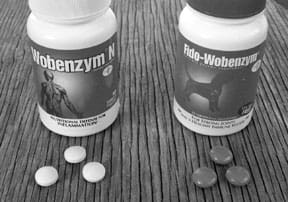Charles Green is America’s largest Wobenzym distributor. When his Las Vegas supplement store was listed as a resource in the article, over a thousand of us ordered the product for our dogs.

“I didn’t know whether to kiss you guys or tear my hair,” says Green. “You bought just about all the Wobenzym we had, and this is a product that’s hard to keep in stock. Most ordered it to help their dogs’ arthritis or cancer. I know it works because today, over four years later, we’re still getting repeat orders from many of the same people. Some are now taking it themselves as well as giving it to their dogs.”
What is Wobenzym?
In Germany, Wobenzym is second in popularity only to aspirin among over-the-counter remedies. It’s also the most thoroughly researched enzyme supplement available worldwide. (The product’s proper name is Wobenzym N, but most call it Wobenzym for short.) Its blend of pancreatin, trypsin, chymotrypsin, bromelain, papain, and rutin would normally act as a digestive aid, but Wobenzym is taken between meals on an empty stomach and its enteric coating protects these ingredients until they are released in the small intestine. From there they move throughout the body, reducing inflammation wherever it occurs by breaking harmful proteins into smaller chains of amino acids. This type of treatment is called “systemic oral enzyme therapy.”
Wobenzym was developed in the 1950s in the United States by Drs. Max Wolf and Helen Benitez of Columbia University, who named the product “wo” for Wolf, “ben” for Benitez, and “zym” for enzymes. Their research showed that proteolytic (protein-digesting) enzymes have four significant properties when circulating through the body: they break down inflammation, break down harmful fibrous tissue, reduce blood viscosity to prevent harmful clotting without the adverse side effects of aspirin and other blood-thinning medications, and they support immune function.
Despite its benefits, Wobenzym did not become a successful supplement until it moved to Germany. It has since been tested in over a hundred medical studies and clinical trials, most conducted in Europe.
Wobenzym is recommended for bruises, sprains, and all types of sports injuries as well as arthritis and any illness that involves inflammation. European Olympic teams use Wobenzym as a preventive (the result is a reported 50-percent reduction in injuries) and, by increasing the dose, to treat any type of trauma injury and accelerate healing.
The bioflavonoid rutin, one of Wobenzym’s ingredients, prevents the discoloration and pain associated with bruises. German surgeons routinely prescribe Wobenzym to prevent bruising, swelling, edema, and pain, significantly reducing post-surgical recovery time, and German hospitals give large amounts to those with serious injuries to prevent brain swelling and speed recovery.
According to its manufacturer, Wobenzym has been shown in clinical trials and medical studies to reduce the incidence of fatal blood clots resulting from the sudden breakdown of vulnerable plaque; increase feelings of well-being; help prevent heart attacks and strokes; help protect the body from environmental toxins; and effectively treat arthritis, autoimmune disorders, rheumatic, and cardiovascular diseases, infections, tumor illnesses, herpes and other viral infections, cancer, hepatitis C, recurrent miscarriages, and many degenerative diseases.
The label-recommended human dose is three tablets twice daily, taken at least 45 minutes before meals, or as recommended by a health care professional. Those health care recommendations are often substantially larger, as Charles Green learned while interviewing physicians and scientists about Wobenzym on his “Health Talk” radio show.
“I’m always being told by these experts,” he says, “that the label dose is extremely conservative. It’s really the recommended maintenance dose for healthy 18-year-olds. As we age or become ill or injured, our bodies deplete their stored enzymes, so larger doses are required for maintenance.
“Among middle-aged arthritis or fibromyalgia sufferers, daily doses of 30 or 40 tablets or more may be needed to alleviate symptoms. Those recovering from accidents, injuries, surgery, or illnesses like cancer often take more. The optimal dose depends on the body’s response. Diarrhea, which results when you take more than you need, is the only adverse side effect documented in humans.
“Anti-inflammatory drugs like aspirin, non-steroidal anti-inflammatory drugs (NSAIDs), and Cox-2 inhibitors kill thousands of Americans and hospitalize many more for the treatment of side effects. Wobenzym is sold in over 40 countries, is taken by millions every day, and has never killed anyone.”
Wobenzym for Dogs?
Two types of Wobenzym are available in the U.S. Both have the same contents, but their coatings differ. Plain Wobenzym is light beige in color, while the product sold as Fido-Wobenzym has a red coating and a less pronounced odor.
“There’s a lot of confusion about Fido-Wobenzym,” says Green. “Some Web sites state that it’s a special formulation developed just for canines, or that the recommended doses of the two versions are different. Neither statement is true.”
Fido-Wobenzym is the same product that’s sold for human use in Europe. Its red coating contains a small amount of sugar and food dyes, and because American consumers wanted a sugar-free product that doesn’t contain coloring agents, the manufacturer created a plain no-sugar coating for the U.S. market. Some people like the red coating better – it’s a matter of personal preference.
Literally, the only difference between the red product and the beige product is the coating, and the only difference between the red product and Fido-Wobenzym is the label. Says Green, “Fido-Wobenzym comes in small containers of 33 or 99 tablets, which makes it more expensive, while regular Wobenzym, which is sold in bottles holding 200, 400, or 800 tablets, is more economical.”
Fido-Wobenzym Arthritis Trial
In 2002, Beverly Cappel, DVM, a holistic veterinarian in Chestnut Ridge, New York, conducted a double-blind placebo-controlled crossover study of Wobenzym N/Fido-Wobenzym in the care and manage-ment of canine arthritis. Sixty dogs diagnosed with various types of arthritis were divided into two groups and given Fido-Wobenzym or identical placebo tablets for six to nine weeks. The study tested doses of one tablet twice per day or two tablets twice per day.
“In Europe, where this preparation is widely used,” explains Dr. Cappel, “it is known to exert joint-sparing and anti-inflammatory effects without the gastrointestinal complications or other complications associated with NSAIDs.”
The dogs in the study continued with their existing protocol (if any) of prescribed medication or natural remedies. Most of the dogs were already receiving supplements such as glucosamine sulfate, chondroitin sulfate, methylsulfonylmethane (MSM), boswellia, alfalfa, and other arthritis-support herbs as well as antioxidant vitamins.
“This was a placebo-controlled trial,” says Dr. Cappel, “but it was obvious which dogs were taking the Wobenzym. They were the ones who stopped limping soon after the study started and were able to go for longer walks. Their owners noted that these dogs appeared to have much less pain. They started acting like young dogs again. A key benefit was the reduction of inflammation. Several patients who responded well were older dogs who were having trouble getting up or couldn’t do stairs or would only go for very short walks. Being able to get up the stairs again or go for longer walks – those are priceless benefits. After the study concluded, many owners came in for refills.”

In a separate small observational study conducted at the same time, eight dogs with cancer were given Fido-Wobenzym. In Europe, Wobenzym is a popular supplement for those with cancer because it may prevent metastasis. “We saw excellent results with small tumors and extended survival periods,” reports Dr. Cappel. “Of the group, two died, but the others did well. Their owners and our own clinical and laboratory indications indicated that the tumors either became static or regressed.”
Most of these dogs were also being given alternative cancer treatments such as carnivora (a European extract of the carnivorous herb Venus fly trap), Chinese herbs, raw-food diets, and turmeric. “Even if your pet is already being given holistic support for cancer,” says Dr. Cappel, “the systemic enzymes seem to help there, too.”
Digestive Enzymes Are Not For Every Dog
But Wobenzym is not without side effects, at least in some dogs. Dr. Cappel first noticed platelet problems in patients whose owners were already giving them Wobenzym for arthritis or cancer at doses higher than Fido-Wobenzym’s label recommendation.
She says that Wobenzym is not likely to produce adverse effects at doses of up to two tablets twice per day (four tablets daily), but as a precaution, she recommends no more than three tablets per day, which she considers very safe. Owners of dogs taking higher amounts, such as six or more tablets daily, should watch for any of the following symptoms, which might indicate platelet problems, internal bleeding, or anemia: small blood spots on the gums, pale gums, any abnormal bleeding, or bloodshot eyes.
Among Dr. Cappel’s patients who developed platelet problems, none became sufficiently anemic to develop white or pale gums. The problem, which occurred in male and female dogs of different ages, breeds, sizes, and conditions, several of which ate a raw home-prepared diet, developed within the first six weeks of daily supplementation with Wobenzym. Immediately reducing the dose or stopping the product resolved these symptoms.
Many dogs have taken substantially larger doses with no difficulty, as described later in this article, but Wobenzym’s combination of enzymes can thin the blood. Wobenzym is not recommended for dogs with bleeding or clotting disorders or for any animal on medication that causes blood thinning.
Those who give their dogs digestive enzymes with food don’t have to worry about platelet problems even if their dogs are on blood-thinning medication or suffer from a bleeding disorder because enzyme powders that are sprinkled on food according to label directions do their work in the stomach, assisting digestion. In systemic oral enzyme therapy, which is where Wobenzym is used, the enzymes are protected from stomach acid and do not interact with food.
Enzymes for Penny’s Eye Ulcer
In November 2000, Penny, a six-year-old Boxer belonging to San Diego resident Pam Klassen, scratched her eye while chasing lizards in deep brush at her favorite lake. The eye became very sore, infected, and running with pus. Penny’s veterinarian prescribed an antibiotic ointment, but that didn’t help.
“Over the next two months we tried several different antibiotics, but nothing seemed to work,” Klassen reports. “The ulcer kept getting worse. The vet finally sent us to a specialist who wanted to perform an operation on her eye, sewing her third eyelid over the eye in hopes of healing the ulcer. The cost would be over a thousand dollars, and he said that it didn’t always work. Fortunately, I had just read the issue of WDJ that contained the ‘Banking on Enzymes’ article (January 2001). After reading about how it helped a dog with cancer and another with a back injury, I decided to give it a try for Penny’s ulcer.”
Klassen started Penny on five Wobenzym tablets per day and added five per day until she saw improvement. “This maxed out at giving her 40 tabs per day in four divided doses of 10 tablets at a time,” she says. “The only side effect she showed was a little diarrhea and gas. If she seemed uncomfortable with her stomach, I would back off a day and let her body rest.
“I first observed that Penny seemed to be in less pain. She was not holding her eye shut, and the discharge slowed, eventually became clear, and finally stopped altogether. Pretty soon I saw tiny blood vessels all over the milky color of the ulcer, which I had learned is a good sign of healing. Then the blood vessels went away and only a slight milky area was visible. That, too, disappeared, and at that point, I began to reduce her dosage. Eventually her eye became clear, sparkly, and healthy with no apparent long-term damage.”
Penny’s first ulcer took about six weeks to cure. “Then she got an ulcer in her other eye,” says Klassen. “I started giving her Wobenzym right away without all the extra vitamins I had used the first time. This time she took 20 tablets per day for less than three weeks, and the ulcer disappeared. She is such a stinker about chasing critters, she is prone to these ulcers. Now if I catch her digging in the yard and she has dirt in her eyes, I promptly wash them out with a mild salt water solution and put her on Wobenzym for several days. Usually she never develops an ulcer at all.
“I saw a woman walking at the lake with a Boxer and while talking to her, I could see that her dog had a big milky ulcer on his eye. When she said they were having a hard time curing it, I told her about my experience. She bought Wobenzym, tried it, and completely cured her dog’s ulcer. This product is amazing! I now take it myself every day as a preventive.”
A Veterinarian’s Enzyme Protocol
Mary Foster, DVM, who practices veterinary medicine in Gainesville, Florida, became interested in systemic oral enzymes five years ago. She has been prescribing Wobenzym for canine patients ever since.
One of her first Wobenzym patients was Elliott, a large Terrier mix with hip dysplasia and severe arthritis in both knees. Elliott was 13 when he slipped on a hardwood floor and couldn’t get up. His owner, Leanne Lawrence, took him to three veterinarians, all of whom recommended that Elliott be euthanized to put him out of his misery. Then she found Dr. Foster, who makes house calls.
“I always carry Wobenzym with me,” says Dr. Foster, “and as soon as I saw Elliot, I started him on five tablets per hour. I also had Leanne encourage him to stand and walk on a safe, carpeted surface, because motion often helps dogs with his condition feel better. Just after his third dose, he and Leanne were walking down the street.”
Elliot resumed his active, roaming life, even though he was diagnosed with bone cancer at 15. “I treated him homeopathically and holistically,” says Dr. Foster, “and the bone tumor went away. It really amazed the veterinarian who did his biopsy, along with everyone else. Elliot finally died in his sleep last winter at 17.”
Dr. Foster prescribes Wobenzym for arthritis, hip dysplasia, injuries, skin and coat problems, autoimmune disorders, and any condition that involves inflammation. Although she uses doses much higher than those on the label, her patients have yet to experience any platelet problems or signs of anemia. “I’ve given it to more than a hundred dogs, most of whom I see on a regular basis,” she says. “Some have been taking it every day for five years. The only situation where I wouldn’t use it would be if the dog has a stomach ulcer, which is rare but can result from taking certain medications.”
How does Dr. Foster decide how much to use? “I usually give it to effect,” she explains. “This means increasing the dose until symptoms respond. For most conditions, I start with one tablet per 10 pounds of body weight up to a maximum of five tablets at a time and give that amount twice or three times a day. In a serious condition where the dog is badly injured or can’t move because of pain, I’ll give that amount more often, like every one or two hours.”
Wobenzym works best if taken on an empty stomach between meals. Dr. Foster reports that most dogs, including her own, will eat the tablets out of her hand. “I use the plain tablets, not the red-coated ones, and they just swallow them. For dogs who aren’t interested, some people flavor the tablets with tuna water. You can give them with a small amount of food if necessary, but it works best without food. For dogs who enjoy catching food, a game of catch can be an easy way to give it.”
Once a dog responds to the initial dose, Dr. Foster stops increasing the amount and looks for an effective maintenance dose. “I study the dog’s symptoms,” she says. “I look for physical comfort, improved range of motion, increased playfulness, and similar improvements. Once the dog is on a daily dose that produces good results, we continue it for several weeks before cutting back. I don’t want to reduce the amount too soon, as a body that’s in damaged condition needs all the enzyme support it can get.
“Then, to see if a smaller dose can maintain good results, we reduce the amount by one or two tablets in each divided dose during the day, then continue at that amount for several weeks unless symptoms recur.”
If the dog injures herself, begins limping, or shows other symptoms, Dr. Foster increases the dose again.
“I’ve noticed that the longer dogs are on a maintenance dose of Wobenzym, the fewer crises they have. It seems to prevent injuries as well as treat them. And the Wobenzym dogs recover much faster from surgery than other dogs. I watch for post-operation swelling and if it occurs, I increase the dose. Otherwise, they just stay on their maintenance dose before and after the operation. If they aren’t already taking Wobenzym, I recommend giving one tablet per 5 pounds of body weight twice a day for small dogs and one tablet per 10 pounds twice a day for large dogs, up to a maximum of five tablets at a time, for a week or two before elective surgery.
“I don’t know what I’d do without Wobenzym,” she concludes. “As far as I’m concerned, it’s a miracle.”
WOBENZYM: OVERVIEW
1. Keep Wobenzym on hand for injuries, or use daily for arthritis, inflammation, skin problems, or auto-immune disease.
2. Follow label directions or use one of the protocols described here.
3. Do not give to dogs with bleeding disorders. Check gums and eyes for spots, paleness, or signs of bleeding. Discontinue or reduce the dose if necessary.
4. Find a safe, effective maintenance dose that keeps your dog comfortable and active.







My Chow Chow was diagnosed on Christmas eve with cancer attached to her spleen. Surgery is an option, but I don’t believe it would be the best thing for her. It seems from this and other of your posts that Wobenzym might help her, but I am unable to find it, except in Europe, and even then it is difficult. It seems to me that the fido-Wobenzym is no longer maid. Can you help?
Thank you,
John
John I just bought the regular wobenzym N off of amazon. As you see from the article they are both the same except for the sugar and food dye in the red which I suspect isn’t good for human or pet.
John – does your dog have hemangiosarcoma? It usually starts on the spleen and is a very aggressive cancer; however sometimes the tumors are benign – only a biopsy will confirm. If so, there is a great group on Facebook with recommended supplements of slowing the cancer. It is called “hemangiosarcoma diet and supplement protocols – a wholistic approach”. Hope your dogs feels better soon. Mine has been cursed with this cancer but is doing wonderfully at the moment.
So if a dog is on a diy raw diet they shouldn’t take Wobenzym N? I am confused. My pom is around 8 pounds and is almost 10. She hurt her leg running one day. I suspect either muscle or cruciate. I have kept her from using it much and over a period of weeks it has gotten better. I dont let her climb stairs or jump up or off things. She also has a benign eyelid tumor which I keep lubricated and she hasn’t had much issue with it. I am just afraid to now giver her the Wobenzym.
What would the dosage be for Wobenzym plus from Mucos pharma? My local health store only carried those. I have a 77lbs Greater swiss mountain dog diagnosed with osteosarcoma in her right proximal humerus
i have been taking Wobenzym for over 25years and its the best ever. No problems and i am a senior over 85 yrs.
Question: Wish to give my 12 old poodle 9lbs.this product. Can i cut one tablet in half and feed by mouth 1/2 twice
per day? I was told some years back that there is no difference between this and Fido Wobenzym. True? If not and you
suggest i use Fido W. where can i get it. Thanks.
You wrote your question 3 years ago but in case you haven’t found it yet, just order people wobenzyme. I give my 12 lb Yorkie 5 wobenzyme ps 2 times a day which is double the wobenzyme n product for arthritis and cushins disease. It seems to be working!!